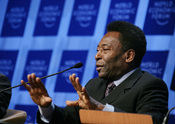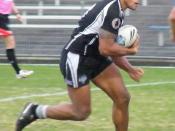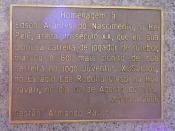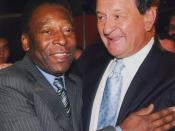"Look at his legs", Dondinho do Nascimento said. "ÃÂHe is going to be a great soccer player." (Haskins 39). The first time that Dondinho saw his son Pele he looked at his legs and knew right away that he was going to be a soccer player. Celeste, Pele's mother, hoped that her son would grow up to be somebody, but she had other hopes in mind besides soccer. "In fact, any other career would do. To Celeste do Nascimento that infernal sport, soccer, was to blame for the couple's poor financial circumstances."(Haskins 30-40) Edson Arantes do Nascimento was born into poverty on October 23, 1970 in Tres Coracoes, Brazil. The reason for the family's poverty was because while his father was a very good soccer player, at that time there were many "very good" soccer players in Brazil.
Dondinho got his first big break in 1942,when he was invited to play for the Atletico Mineiro, a professional soccer team in Belo Horizonte.
But he was forced to return home after suffering a knee injury in the first game. Dondinho got a second chance later on that year, when he was invited to play for the Hipacre Club in Lorena. He joined the team and moved his family to Lorena at a time (1942) when Pele was only two years old.
When Pele was four, his father changed teams again, and they moved to Bauru.
This is where Pele started playing soccer with the neighborhood boys. Pele and the younger boys were not allowed to play with the older boys, so they organized their own team which they called Ameripuinha. As soon as they had collected enough socks to make a ball, they were ready for there first game. "I'll never forget that afternoon,"Pele recalls.
"That was our was our team and I was very proud."(Haskins 47). They played together for a couple of years but eventually the Ameripuinha team disbanded. Pele found himself a player without a team.
Pele was lost without a team. He did not go to school; all he did was kick a soccer ball around. All Pele could do was hope for some kind of break that would enable him to play for a team again. That break came in 1952, when he was only twelve years old. The Bavro Athletic Club decided to sponsor a youth team, and Pele was overjoyed when he was invited to be on the team. He accepted without question. He was so excited when he found out that the team was going to be coached by a legend in Brazil, Valdemar De Brito, who had been a soccer star long before Pele was born. Although, Pele had never actually seen the retired star play, people would note the remarkable resemblance between their playing styles. Before long the Bavro Athletic Club (BAC) team had built a solid reputation in Bavro. Often they attracted more spectators that the BAC professional team, the team that Pele's father played on. Shortly after Pele was starting to connect and learn a lot from his new coach, he learned that Valdemer had been offered a better job in Sao Paulo, and was going to leave Bauru .Pele and the other boys lost their spirit and could not summon the morale or the energy to play as well for the new coach. They were looking forward to several more years of instruction from Valdemer. After Valdemer left, Pele had no more interest in playing for the (BAC) team. A few months later, a well-known player from Rio De Janeiro, who had heard about what a great player Pele was, visited him and invited him to go back to Rio with him. Dondinho was very proud of his son, but at the same time very cautious about letting him go. At this time, Pele was only fifteen years old and this was a very big step for Pele.
Realizing that his son's age would be a problem, Dondinho refused to give his permission and Pele watched his "Big opportunity" vanish. As it turned out, denying Pele that opportunity, left him free to accept a greater opportunity.
A few months later, his former coach Valdemar returned from Sao Paul looking for Pele. The team that he was coaching, Santos, was looking for new talent. and he knew that Pele was just what they were looking for. The only problem was that Pele's mother was very much against the idea of Pele leaving home and being on his own at such a young age. Valdemar assured her that he would take care of her son and she finally agreed. "I'll never forget, her words," Pele recalls "but he is still a baby, she said, he must have somebody to watch over him." ( Haskins 67) Not long after he had arrived, the president of the Santos Club offered Pele a contract. After talking it over with his parents, Pele signed with the Santos team and became a professional soccer player. Pele would be paid about $120.00 a month, and his room and board would be free. (Haskins 70-71) As time passed Pele gained more experience and his game improved. At age 16, and only a year on the team , he was given a starting position as a forward. That year passed quickly for Pele, and because of the number of goals he scored, he was named athlete of the year. (Haskins 72) After the season ended, Pele went home to spend his off time with his family. One day he was sitting at home listening to the radio when he heard the announcer give the list of players who had been chosen to play on the Brazilian National team. Pele could hardly believe it when he heard that he was one of the players chosen.
One the first day of the tournament Pele was especially calm, for he was quite sure that he would not play in the game that day. But to his surprise, the coach ordered him to warm up and get ready to go in. When he entered the game Brazil was losing 1-0 to Argentina. Within minutes, Pele saw his chance to set up a goal. He gave a quick give and go and set up his teammate for a goal. The stadium exploded. There was no question that the youngster from Bauru had established himself ( Haskins 76-77) Shortly after that he suffered a serious knee injury. He started to train for the 1958 Would cup tournament but due to his injury he was put on the reserve team and would not be allowed to play. He watched his team beat Austria in the first round, and tie England in the second round of the World cup. In the third round they played the Soviet Union, Pele got his chance to start , and they won 1-0. Then his team went on to defeat France 5-2 in the quarter finals with the help of Pele's three goals. The Brazilians went on to defeat the Swedish team 5-2 in the finals.(Haskins 89) Pele led the Brazilian National Soccer team to two more World cup victories in 1962 and 1970.
In 1966 when Pele was 20 years old, he received a tremendous salary of $150,000 a year and a $27,00 cash bonus and a new Volkswagen. Pele's fame and fortune not only changed his life, but it also changed his family's life with all the money he earned. He was able to buy a large house for his family in a better part of Bauru. This was the first time Pele felt extremely proud of himself and of his accomplishments. (Haskins 95) Pele continued to stand out and lead his team to victory. But in 1966 he decided that it was time to get married. Her name was Rosemarie de Cholby, and she was a native to Santos. In 1967 they had a daughter named Kelly Christina. Soccer was not the most important thing in his life now; it was his family. Pele planned to retire that year, but shortly after this 25th birthday he signed with Santos for three more years at $4500.00 a month. Then on November 19, 1969 Pele scored his 1,000 goal on a penalty kick against Argentina. This was one of his proudest moments. And for years after that he was known as "O Rei Pele ( King Pele)" (Thebaud 29). On June 18, 1971, just one year after the coronation at Azteca Stadium, he bade farewell to the team to which his destiny had been linked for 14 years. And on October 2, 1974 in the Villa Belmiro stadium he saluted his teammates and the spectators at the end of a game played against Ponte Preta. "Pele had put an end to his career, just as he said he would."(Thebaud 32-33) He ended his career scoring a total of 1,220 goals in 1,254 regular league games.
Just one year after the legendary athlete retired from the game he loved, he announced that he was coming back. In 1975 the New York Cosmos of the North American Soccer league offered Pele a $7 million contract for three years. He came out of retirement not for the money, but because he felt that he could make soccer popular in the United States. After Pele had played in the States and opened the peoples eyes to soccer he decided it was time to retire again, this time for good, in 1977.
Pele was by far the most talented and inspirational player to ever play the game of soccer. He had far more accomplishments than any other player. Pele was the only player to win 3 World cups, the first player to score 1,000 goals, and the first black athlete to have his picture on the cover of Life magazine. Pele has inspired so many young children to follow their dreams and to never give up or stop trying. He changed the way soccer was played and brought the sport to National attention.





